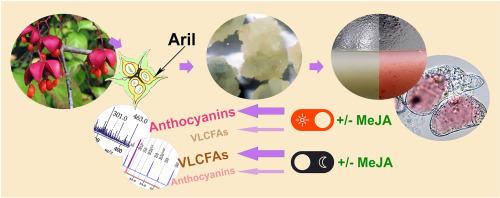Euonymus maximowiczianus aril-derived long-term suspension-cultured cells:光和茉莉酸甲酯对花青素和 VLCFA 积累的影响
IF 5.7
2区 生物学
Q1 PLANT SCIENCES
引用次数: 0
摘要
欧鼠李属(Euonymus (L.))由灌木和木本植物组成,主要分布在北半球。此外,在一些欧鼠李属植物的果实中发现了脂肪油,这种油不仅在种子中积累,而且在假种皮中也有积累。本研究介绍了对当地特有植物 Euonymus maximoviczianus Prokh.悬浮细胞仍能形成含有中性脂质的油滴。在黑暗中生长的细胞(Em-D 培养物)和在光照下生长的细胞(Em-L 培养物)都能合成超长链脂肪酸(VLCFAs)以及青花素-3-O-己糖苷、花翠素-3-O-己糖苷和芍药苷-3-O-己糖苷。在此,我们研究了亚培养过程中 VLCFA 和花青素的积累动态,以及茉莉酸甲酯(MeJA)和光照对这些过程的影响。在黑暗条件下,VLCFA 的形成更为旺盛,而在光照条件下,花青素的生物合成被显著激活。在 Em-L 细胞中,超过 76% 的花青素是由花青素-3-O-己糖苷合成的,而在 Em-D 细胞中,花青素-3-O-己糖苷的合成更为活跃(45%)。在 Em-L 和 Em-D 细胞培养物中,MeJA 大大提高了花青素的积累(尤其是在光下),而且令人惊讶的是,还提高了 VLCFAs 的形成。讨论了 VLCFAs 和花青素的生物合成途径之间可能存在的竞争,这与它们的前体丙二酰-CoA 的细胞质池的共性有关。本文章由计算机程序翻译,如有差异,请以英文原文为准。

Euonymus maximowiczianus aril-derived long-term suspension-cultured cells: Light and methyl jasmonate impact in the anthocyanin and VLCFA accumulation
The genus Euonymus (L.) consists of shrubs and woody plants, distributed mainly in the Northern Hemisphere. Several hundred of secondary metabolites have been isolated from Euonymus spp. In addition, fatty oil was found in the fruits of some Euonymus spp., which accumulates not only in the seeds but also in the arils. This study presents the research of unique over ten-year-old suspension cell cultures of the endemic plant Euonymus maximoviczianus Prokh., obtained from the aril tissue of unripe capsules. The suspension cells retain the ability to form oil droplets containing neutral lipids. Both cells growing in the dark (Em-D culture) and cells growing in the light (Em-L culture) can synthesize very-long-chain fatty acids (VLCFAs) as well as cyanidin-3-O-hexoside, delphinidin-3-O-hexoside, and peonidin-3-O-hexoside. Here, we researched the VLCFA and anthocyanin accumulation dynamics during subcultivation, as well as the influence of methyl jasmonate (MeJA) and light on these processes. In the darkness, the formation of VLCFAs was more intense, while the biosynthesis of anthocyanins was significantly activated in the light. In Em-L cells, more than 76% of anthocyanins were represented by cyanidin-3-O-hexoside, and in Em-D cells delphinidin-3-O-hexoside was more actively synthesized (45%). MeJA substantially enhanced the accumulation of anthocyanins (especially in the light) and, surprisingly, the formation of VLCFAs in both Em-L and Em-D cell cultures. The possible competition between the biosynthetic pathways of VLCFAs and anthocyanins is discussed in connection with the commonality of the cytosolic pool of their precursor, malonyl-CoA.
求助全文
通过发布文献求助,成功后即可免费获取论文全文。
去求助
来源期刊
CiteScore
11.10
自引率
3.10%
发文量
410
审稿时长
33 days
期刊介绍:
Plant Physiology and Biochemistry publishes original theoretical, experimental and technical contributions in the various fields of plant physiology (biochemistry, physiology, structure, genetics, plant-microbe interactions, etc.) at diverse levels of integration (molecular, subcellular, cellular, organ, whole plant, environmental). Opinions expressed in the journal are the sole responsibility of the authors and publication does not imply the editors'' agreement.
Manuscripts describing molecular-genetic and/or gene expression data that are not integrated with biochemical analysis and/or actual measurements of plant physiological processes are not suitable for PPB. Also "Omics" studies (transcriptomics, proteomics, metabolomics, etc.) reporting descriptive analysis without an element of functional validation assays, will not be considered. Similarly, applied agronomic or phytochemical studies that generate no new, fundamental insights in plant physiological and/or biochemical processes are not suitable for publication in PPB.
Plant Physiology and Biochemistry publishes several types of articles: Reviews, Papers and Short Papers. Articles for Reviews are either invited by the editor or proposed by the authors for the editor''s prior agreement. Reviews should not exceed 40 typewritten pages and Short Papers no more than approximately 8 typewritten pages. The fundamental character of Plant Physiology and Biochemistry remains that of a journal for original results.

 求助内容:
求助内容: 应助结果提醒方式:
应助结果提醒方式:


